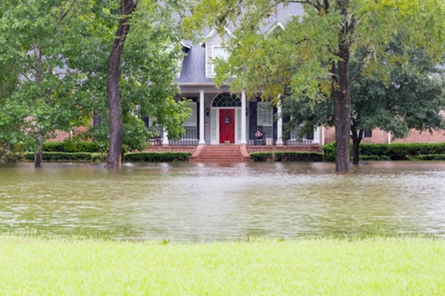
No matter where you live, inclement weather can impact you with very little warning. This is especially true during spring storm season when unpredictable weather is quite common. Intense winds, heavy rain, hailstorms, tornadoes, and flooding can wreak havoc on your home, leaving you with costly repairs including damaged roofs, broken windows, or wind damage to the structure of your property.
Fortunately, there are several ways you can prevent potential weather damage and prepare for severe weather before disaster strikes. Read the following emergency preparedness suggestions to limit the impacts that spring storms could have on your home.
What Kind Of Damage Can A Spring Storm Cause To Your Home?
- Roof or structural damage to your walls from a fallen tree or high winds
- Broken windows from hailstorms or objects thrown by heavy wind
- Lightning strikes, which could lead to a fire
- Fallen or damaged power lines due to large tree branches
- Water damage caused by loose or damaged shingles, clogged gutters, or leaking roofs
- Flooding in your basement or home
- Loss of electricity
- Animal infestations caused by critters looking for shelter during the storm
Steps To Take Before A Spring Storm Hits
1. Clean Out Gutters & Downspouts
Clogged gutters, drains, and downspouts can lead to roof damage during a storm. Dirt and debris can cause water to be unable to flow away from the roofline, adding weight to your roof and potentially causing a roof collapse. Before the spring storms strike, check your downspouts and gutters to ensure that winter storms haven’t created any blockages. While you’re up there, make sure that all connections are secure and that no repairs are necessary.
2. Seal Your Windows, Doors, & Roof
Check the seals around your doors and windows. Look for loose screws and cracked caulking and make repairs if necessary. If you live in an area that's prone to heavy storms, consider investing in impact-resistant windows to protect your home.When you inspect your doors, check that there are three hinges on each to provide additional support. Then, make sure your threshold is screwed directly into your house, as opposed to only your door frame.Next, inspect your roof. If you find any missing or damaged shingles, an area of sagging, or other damage, have your roof professionally inspected before a storm hits. Repairs can keep your home from experiencing severe damage due to a leaky roof.
3. Search For Cracks In The Foundation
Even small cracks in your foundation or basement can put your home at risk of major damage during a spring storm. If water seeps in through the cracks, your home could be in danger of flooding. Furthermore, high winds can make existing cracks prone to widening, causing significant structural damage throughout the home. If you find or suspect any cracks in your foundation or basement, call a professional to seal them to help you prepare for a flood.
4. Install A Backflow Valve In Your Basement To Prevent Sewage Backup
Heavy rain can cause municipal sewers systems to become overtaxed, creating the possibility for excess water to flow backward through your home's sewer lines. Plumbing fixtures situated at the lowest points in your home may be particularly prone to sewer backup. Consider installing a sewer backflow valve to divert unexpected water away from your sewer lines and back to your city's sewage system.
What To Do If You Experience Storm Damage
Ensure The Safety Of You And Your Family
An intense windstorm or tornado may have caused damage to your home but ensuring that your family is safe is key. Check for any injuries and, if needed, contact emergency services, go to the hospital, or treat a wound to ensure the safety of your loved ones. Prior to the storm, make sure that all family members are in a safe location away from windows and doors that may be damaged due to the weather conditions.
Turn Off Damaged Gas, Water, Or Electricity Lines
After the storm has subsided, check to make sure gas, water, and electricity lines are not damaged. If you suspect there is damage and are able to turn off the lines safely, do so to ensure further harm to your home. If you don’t know how to do this, it's best to call an expert to come and ensure that you and your family are safe from danger.
Inspect Damage Around Your Home And Take Pictures
There are a variety of ways in which a home can be damaged. High winds and lightning strikes may have caused trees to fall, which may lead to property damage such as broken windows, collapsed walls, or damaged roofs. Rain may have also soaked furniture, carpeting, and other flooring in damaged areas of the home through cracks or leaks, leading to mold. As you go through your house inspection, make sure to take pictures for your insurance claim.
Contact Your Insurance Company
Having homeowner’s insurance is important, especially in areas that are prone to flooding or tornadoes. If your home has been damaged, it's important that you contact your insurance provider to notify them. An insurance adjuster will be sent to determine the damage extent and provide a payment for repairs if applicable. If your policy does not yet have adequate coverage, you may want to consider contacting an insurance specialist to ensure you have coverage before you have a problem.
Prevent Further Impact To Your Property From Storm Damage
If a major storm causes damage to your home, take the necessary steps toward recovery as quickly as possible. Before you begin cleaning up, contact your insurance agency immediately to report the damage. Then, contact a professional disaster restoration company to review your home. ServiceMaster Restore has a team of experts who are ready to help you restore your home and your peace of mind 24/7/365. Call us at 1-800-RESPOND.
